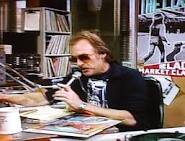I snapped this rose decal on a Celica next to me in the CUNY parking lot. It's missing the "A Touch of Class," always in a feminine script, that accompanied it on so many cars, T-shirts, and tattoos of the 70s. Then, it served as a defiant gesture of dignity for greasers, trailer trash, minimum wage workers--as Myles might put, The Plain People of Plainfield, Taftville, Groton, and everywhere...
So I was pleased to see it on the same day as a rally on the campus to protest tuition hikes. The speakers made the connection, appropriately, to the Occupy Wall Street demonstrations. If the millionaires and billionaires paid their fair share of taxes, they argued, the state would be able to adequately support public higher education. "CUNY is our only shot," the chant went.
One protester's sign, on the inside cover of a pizza box, caught my eye: "What happened to the Free Academy?" Yes, CUNY was founded in 1847 as the
Free Academy with a mission to educate graduates of New York City public schools. While the name changed to the City University of New York long ago, CUNY continued to provide free tuition to New York City kids until the financial crisis of 1975. And the tuition has more than kept pace with inflation ever since.
 |
| The Pizza Revolution |
Myself a graduate of a high school
freak academy (I meant "free," but let it stand), where admittedly I nearly flunked out of my "Senior Math" class, I offer a reasonable solution to the funding crisis in higher education, to wit: Once you reach the $1,000,000 annual income level, you pay back (on a reasonable schedule) the educational benefits you received from city, state, and federal sources. So, for example, if you didn't pay tuition at your CUNY college, you make it up by paying now. The same with Pell Grants and a host of other publicly supported educational benefits. This revenue would go into a publicly administered fund to support today's needy college students, who, once they reach the 1M benchmark will pay back the benefits they will have received.
The plan is simple, fair, and, if I do say my so myself, classy.
This post dedicated to your correspondent's sister, Teresa, a fellow educator, who does everything with "a touch of class."



















 (This post goes out to my parents who introduced us to Arlo Guthrie, VW Microbuses, and the idea that a society could be about fairness, justice, and peace. They have only themselves to blame.)
(This post goes out to my parents who introduced us to Arlo Guthrie, VW Microbuses, and the idea that a society could be about fairness, justice, and peace. They have only themselves to blame.)



 If you checked out the Reducers' "Roadrunner" from 1981 on yesterday's post, you are probably thinking about Jonathan Richman today. Jonathan recorded his first version of the song in 1972, but it wasn't released until 1976. And it's had a hold on the zeitgeist ever since. A paean to driving, AM radio, Route 128, Stop & Shop. Here's a nice, if obsessive piece, by Laura Barton, a Guardian (UK) writer who spent a lot of time driving 128 and hanging out in Natick--yes, she both drove by and walked by the Stop & Shop--to commune with the song.
If you checked out the Reducers' "Roadrunner" from 1981 on yesterday's post, you are probably thinking about Jonathan Richman today. Jonathan recorded his first version of the song in 1972, but it wasn't released until 1976. And it's had a hold on the zeitgeist ever since. A paean to driving, AM radio, Route 128, Stop & Shop. Here's a nice, if obsessive piece, by Laura Barton, a Guardian (UK) writer who spent a lot of time driving 128 and hanging out in Natick--yes, she both drove by and walked by the Stop & Shop--to commune with the song.













 Who will accept the prize? Don't be surprised if the old gent's bicycle itself shows up to do the honors. There's still time to contact your bookmaker. (Forward the customary 10% of winnings to: The Research Bureau, C/o Benito's Italian Restaurant, 46/47 Castle Street (Opposite Tramyard), Dalkey, County Dublin, Eire.)
Who will accept the prize? Don't be surprised if the old gent's bicycle itself shows up to do the honors. There's still time to contact your bookmaker. (Forward the customary 10% of winnings to: The Research Bureau, C/o Benito's Italian Restaurant, 46/47 Castle Street (Opposite Tramyard), Dalkey, County Dublin, Eire.)

